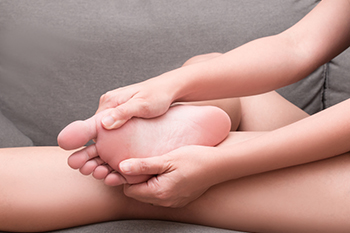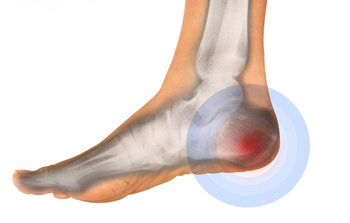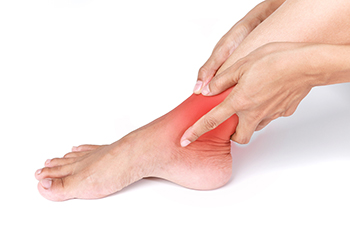North Andover (978) 686-7623
Tewksbury (978) 640-1010
Blog
 People who enjoy the sport of running may experience an uncomfortable foot condition known as sesamoiditis. It is defined as an inflammatory ailment that affects the ball of the foot. The pain is felt underneath the big toe where the two sesamoid bones are located. They are located inside of the large tendon that is found under the big toe, and provides power and leverage when pushing off while walking or running. Many people who are afflicted with sesamoiditis describe the feeling as stepping on marbles or pebbles. One of the leading causes of this condition is due to tightness in the toe flexors. Relief may be found when specific toe stretches are performed as this may alleviate some of the tightness. If you have pain in this part of your foot, it is suggested that you speak with a podiatrist who can properly diagnose this condition and effectively treat you.
People who enjoy the sport of running may experience an uncomfortable foot condition known as sesamoiditis. It is defined as an inflammatory ailment that affects the ball of the foot. The pain is felt underneath the big toe where the two sesamoid bones are located. They are located inside of the large tendon that is found under the big toe, and provides power and leverage when pushing off while walking or running. Many people who are afflicted with sesamoiditis describe the feeling as stepping on marbles or pebbles. One of the leading causes of this condition is due to tightness in the toe flexors. Relief may be found when specific toe stretches are performed as this may alleviate some of the tightness. If you have pain in this part of your foot, it is suggested that you speak with a podiatrist who can properly diagnose this condition and effectively treat you.
Sesamoiditis is an unpleasant foot condition characterized by pain in the balls of the feet. If you think you’re struggling with sesamoiditis, contact one of our podiatrists of Foot Health Center of Merrimack Valley. Our doctors will treat your condition thoroughly and effectively.
Sesamoiditis
Sesamoiditis is a condition of the foot that affects the ball of the foot. It is more common in younger people than it is in older people. It can also occur with people who have begun a new exercise program, since their bodies are adjusting to the new physical regimen. Pain may also be caused by the inflammation of tendons surrounding the bones. It is important to seek treatment in its early stages because if you ignore the pain, this condition can lead to more serious problems such as severe irritation and bone fractures.
Causes of Sesamoiditis
- Sudden increase in activity
- Increase in physically strenuous movement without a proper warm up or build up
- Foot structure: those who have smaller, bonier feet or those with a high arch may be more susceptible
Treatment for sesamoiditis is non-invasive and simple. Doctors may recommend a strict rest period where the patient forgoes most physical activity. This will help give the patient time to heal their feet through limited activity. For serious cases, it is best to speak with your doctor to determine a treatment option that will help your specific needs.
If you have any questions please feel free to contact one of our offices located in North Andover, and Tewksbury, MA . We offer the newest diagnostic and treatment technologies for all your foot and ankle needs.

Circulatory problems in the legs and feet can occur simply from sitting or standing in the same position for a prolonged time or not moving your toes enough. Unfortunately, this can lead to blood clots or deep vein thrombosis – two possibly fatal conditions. Poor blood circulation can also result from thickened arteries caused by age, family history, diabetes, or high cholesterol. A healthy diet and regular exercise (including wiggling your toes and rotating your ankles daily) are the best things you can do to improve your chances of good blood flow to your lower extremities. Signs that you may be suffering from poor circulation can include numbness, tingling, pain in your feet, cold toes or fingers, and/or pale or blue-tinged skin. If you suspect you have poor circulation, speak to a podiatrist about solutions and treatment available.
While poor circulation itself isn’t a condition; it is a symptom of another underlying health condition you may have. If you have any concerns with poor circulation in your feet contact one of our podiatrists of Foot Health Center of Merrimack Valley. Our doctors will treat your foot and ankle needs.
Poor Circulation in the Feet
Peripheral artery disease (PAD) can potentially lead to poor circulation in the lower extremities. PAD is a condition that causes the blood vessels and arteries to narrow. In a linked condition called atherosclerosis, the arteries stiffen up due to a buildup of plaque in the arteries and blood vessels. These two conditions can cause a decrease in the amount of blood that flows to your extremities, therefore resulting in pain.
Symptoms
Some of the most common symptoms of poor circulation are:
- Numbness
- Tingling
- Throbbing or stinging pain in limbs
- Pain
- Muscle Cramps
Treatment for poor circulation often depends on the underlying condition that causes it. Methods for treatment may include insulin for diabetes, special exercise programs, surgery for varicose veins, or compression socks for swollen legs.
As always, see a podiatrist as he or she will assist in finding a regimen that suits you. A podiatrist can also prescribe you any needed medication.
If you have any questions, please feel free to contact one of our offices located in North Andover, and Tewksbury, MA . We offer the newest diagnostic and treatment technologies for all your foot care needs.

Walking is one of the best ways to stay active during pregnancy. It is low impact, so it doesn’t endanger your knees and ankles, plus it’s good for the heart and lungs. It also can be a way to meet up with friends and share the experience. Anyone who has been inactive prior to pregnancy should check with a medical professional before introducing a walking program. In the beginning, it is recommended that you start with 15 minutes, 3 times a week. This can be increased over time to 30 minutes, 4 or more times a week. Be sure to wear comfortable walking shoes that have adequate support and cushioning. As you walk, place your heel on the ground and roll onto your toes, rather than placing a flat foot on the ground. During the second trimester, as the baby grows, pay special attention to your posture when walking. Keep your back straight and your eyes forward and swing your arms to help with balance. Your hips and ankles may become more stressed, especially as your center of gravity changes. By the third trimester, avoid steep hills or uneven pathways that may affect your balance, and be sure to walk with a buddy. If at any time you experience unusual foot or ankle pain or swelling, it is a good idea to consult with a podiatrist for an examination as soon as possible.
Pregnant women with swollen feet can be treated with a variety of different methods that are readily available. For more information about other cures for swollen feet during pregnancy, consult with one of our podiatrists from Foot Health Center of Merrimack Valley. Our doctors will attend to all of your foot and ankle needs.
What Foot Problems Can Arise During Pregnancy?
One problem that can occur is overpronation, which occurs when the arch of the foot flattens and tends to roll inward. This can cause pain and discomfort in your heels while you’re walking or even just standing up, trying to support your baby.
Another problem is edema, or swelling in the extremities. This often affects the feet during pregnancy but tends to occur in the later stages.
How Can I Keep My Feet Healthy During Pregnancy?
- Wearing orthotics can provide extra support for the feet and help distribute weight evenly
- Minimize the amount of time spent walking barefoot
- Wear shoes with good arch support
- Wear shoes that allow for good circulation to the feet
- Elevate feet if you experience swelling
- Massage your feet
- Get regular, light exercise, such as walking, to promote blood circulation to the feet
If you have any questions please feel free to contact one of our offices located in North Andover, and Tewksbury, MA . We offer the newest diagnostic and treatment technologies for all your foot and ankle needs.

If you are experiencing pain on the bottom of your heel, there is a good chance that you may have a condition known as plantar fasciitis. Plantar fasciitis is an irritation and inflammation of the plantar fascia, which is a connective tissue that links the heel with the toes. Because the plantar fascia is located on the sole of the feet, it helps absorb the body’s weight, and can become overly stressed during walking, running, and jumping movements. Plantar fasciitis is the most common cause of heel pain and can make it difficult to walk. Common risk factors for plantar fasciitis include making certain repetitive movements (as in running) obesity, sudden weight gain (as in pregnancy), or by having flat feet or high arches or a tightened Achilles tendon. If you believe you have plantar fasciitis, make an appointment with a podiatrist to be properly diagnosed and to receive prompt and proper treatment.
Plantar fasciitis can be very painful and inconvenient. If you are experiencing heel pain or symptoms of plantar fasciitis, contact one of our podiatrists from Foot Health Center of Merrimack Valley. Our doctors can provide the care you need to keep you pain-free and on your feet.
What Is Plantar Fasciitis?
Plantar fasciitis is the inflammation of the thick band of tissue that runs along the bottom of your foot, known as the plantar fascia, and causes mild to severe heel pain.
What Causes Plantar Fasciitis?
- Excessive running
- Non-supportive shoes
- Overpronation
- Repeated stretching and tearing of the plantar fascia
How Can It Be Treated?
- Conservative measures – anti-inflammatories, ice packs, stretching exercises, physical therapy, orthotic devices
- Shockwave therapy – sound waves are sent to the affected area to facilitate healing and are usually used for chronic cases of plantar fasciitis
- Surgery – usually only used as a last resort when all else fails. The plantar fascia can be surgically detached from the heel
While very treatable, plantar fasciitis is definitely not something that should be ignored. Especially in severe cases, speaking to your doctor right away is highly recommended to avoid complications and severe heel pain. Your podiatrist can work with you to provide the appropriate treatment options tailored to your condition.
If you have any questions please feel free to contact one of our offices located in North Andover, and Tewksbury, MA . We offer the newest diagnostic and treatment technologies for all your foot and ankle needs.
Sometimes after a sprained ankle begins to heal, the ankle joint may still hurt and become swollen. It also may click or lock and become stiff. The pain worsens when bearing weight. The cause may be an overlooked fracture of the cartilage that sits just under the lower leg bone (tibia) and the top ankle bone (talus). The fancy name for this condition is osteochondral lesions of the talus, and another bone scan or MRI may be necessary to properly diagnose it. The injury is likely to occur when the tibia lands directly on the talus, thereby compressing the cartilage in between the two bones. In some cases a bit of cartilage breaks off but remains in place. There are five levels of severity and treatment, ranging from non-surgical methods to arthroscopic surgery. If left untreated, osteochondral lesions of the talus may cause chronic pain and swelling, limit joint motion, or result in bone damage. If such ankle problems continue following a sprain, it is a good idea to see a podiatrist for in-depth investigation and diagnosis of the injured site.
Sports related foot and ankle injuries require proper treatment before players can go back to their regular routines. For more information, contact one of our podiatrists of Foot Health Center of Merrimack Valley. Our doctors can provide the care you need to keep you pain-free and on your feet.
Sports Related Foot and Ankle Injuries
Foot and ankle injuries are a common occurrence when it comes to athletes of any sport. While many athletes dismiss the initial aches and pains, the truth is that ignoring potential foot and ankle injuries can lead to serious problems. As athletes continue to place pressure and strain the area further, a mild injury can turn into something as serious as a rupture and may lead to a permanent disability. There are many factors that contribute to sports related foot and ankle injuries, which include failure to warm up properly, not providing support or wearing bad footwear. Common injuries and conditions athletes face, including:
- Plantar Fasciitis
- Plantar Fasciosis
- Achilles Tendinitis
- Achilles Tendon Rupture
- Ankle Sprains
Sports related injuries are commonly treated using the RICE method. This includes rest, applying ice to the injured area, compression and elevating the ankle. More serious sprains and injuries may require surgery, which could include arthroscopic and reconstructive surgery. Rehabilitation and therapy may also be required in order to get any recovering athlete to become fully functional again. Any unusual aches and pains an athlete sustains must be evaluated by a licensed, reputable medical professional.
If you have any questions please feel free to contact one of our offices located in North Andover, and Tewksbury, MA . We offer the newest diagnostic and treatment technologies for all your foot and ankle needs.
 April is Foot Health Month! To honor the importance of good foot health and prepare for the warmer months and more attractive sandal-wearing, we can give our feet the proper time and attention they deserve for all they do for us. Because of all we subject our feet to, they are the part of the body that is most apt to sustain injury. Proper foot care is simple if tended to regularly. The things to do to care for your feet are routinely washing them and making sure to dry them completely, moisturizing the feet to prevent dry, cracked skin, avoiding lotion in between the toes, ensuring the proper fitting of shoes, choosing supportive shoes and socks that are not tight or irritating to feet, alternating the shoes you wear daily and changing up heel heights, wearing clean socks each day that socks are worn, and not going barefoot for extended time periods. Women who are pregnant, older, or have health conditions, like diabetes or poor circulation, need to pay additional attention to specific things related to their feet. For example, pregnant and elderly women need to wear shoes that have better shock absorbency, and women with diabetes need to check their feet regularly to make sure nothing unusual is going on that they may not feel. If getting pedicures in a salon is something that you do, make sure the tubs and instruments used are well sanitized. Most of these suggestions (other than pregnancy-related foot care) apply to men and women alike. Consulting with a podiatrist as part of your regular health care is a good practice to make sure these vital parts of the body are well maintained and painful foot problems, even disability, are prevented.
April is Foot Health Month! To honor the importance of good foot health and prepare for the warmer months and more attractive sandal-wearing, we can give our feet the proper time and attention they deserve for all they do for us. Because of all we subject our feet to, they are the part of the body that is most apt to sustain injury. Proper foot care is simple if tended to regularly. The things to do to care for your feet are routinely washing them and making sure to dry them completely, moisturizing the feet to prevent dry, cracked skin, avoiding lotion in between the toes, ensuring the proper fitting of shoes, choosing supportive shoes and socks that are not tight or irritating to feet, alternating the shoes you wear daily and changing up heel heights, wearing clean socks each day that socks are worn, and not going barefoot for extended time periods. Women who are pregnant, older, or have health conditions, like diabetes or poor circulation, need to pay additional attention to specific things related to their feet. For example, pregnant and elderly women need to wear shoes that have better shock absorbency, and women with diabetes need to check their feet regularly to make sure nothing unusual is going on that they may not feel. If getting pedicures in a salon is something that you do, make sure the tubs and instruments used are well sanitized. Most of these suggestions (other than pregnancy-related foot care) apply to men and women alike. Consulting with a podiatrist as part of your regular health care is a good practice to make sure these vital parts of the body are well maintained and painful foot problems, even disability, are prevented.
Everyday foot care is very important to prevent infection and other foot ailments. If you need your feet checked, contact one of our podiatrists from Foot Health Center of Merrimack Valley. Our doctors can provide the care you need to keep you pain-free and on your feet.
Everyday Foot Care
Often, people take care of their bodies, face and hair more so than they do for their feet. But the feet are a very important aspect of our bodies, and one that we should pay more attention to. Without our feet, we would not be able to perform most daily tasks.
It is best to check your feet regularly to make sure there are no new bruises or cuts that you may not have noticed before. For dry feet, moisturizer can easily be a remedy and can be applied as often as necessary to the affected areas. Wearing shoes that fit well can also help you maintain good foot health, as well as making it easier to walk and do daily activities without the stress or pain of ill-fitting shoes, high heels, or even flip flops. Wearing clean socks with closed shoes is important to ensure that sweat and bacteria do not accumulate within the shoe. Clean socks help to prevent Athlete’s foot, fungi problems, bad odors, and can absorb sweat.
If you have any questions please feel free to contact one of our offices located in North Andover, and Tewksbury, MA . We offer the newest diagnostic and treatment technologies for all your foot and ankle needs.
 Cuboid syndrome is a foot condition that affects the cuboid bone, which is one of seven tarsal bones that are located in the middle of the foot. Additionally, it can be referred to as cuboid subluxation, and it may develop after a joint or ligament injury. Patients with cuboid syndrome can experience limping, swelling, and tenderness in the affected foot. While research has indicated that trauma to the foot is the most common cause of cuboid syndrome, some patients have overpronation or underpronation, which can lead to an increase in the risk of injury. This condition may also happen gradually, as the foot can endure stress a day at a time. Relief may come from resting the foot as often as possible, and it can help to wear proper shoes. If you have pain in your foot, it is suggested that you consult with a podiatrist who can perform proper testing for cuboid syndrome and offer correct treatment options.
Cuboid syndrome is a foot condition that affects the cuboid bone, which is one of seven tarsal bones that are located in the middle of the foot. Additionally, it can be referred to as cuboid subluxation, and it may develop after a joint or ligament injury. Patients with cuboid syndrome can experience limping, swelling, and tenderness in the affected foot. While research has indicated that trauma to the foot is the most common cause of cuboid syndrome, some patients have overpronation or underpronation, which can lead to an increase in the risk of injury. This condition may also happen gradually, as the foot can endure stress a day at a time. Relief may come from resting the foot as often as possible, and it can help to wear proper shoes. If you have pain in your foot, it is suggested that you consult with a podiatrist who can perform proper testing for cuboid syndrome and offer correct treatment options.
Cuboid syndrome, also known as cuboid subluxation, occurs when the joints and ligaments near the cuboid bone in the foot become torn. If you have cuboid syndrome, consult with one of our podiatrists from Foot Health Center of Merrimack Valley. Our doctors will assess your condition and provide you with quality foot and ankle treatment.
Cuboid syndrome is a common cause of lateral foot pain, which is pain on the outside of the foot. The condition may happen suddenly due to an ankle sprain, or it may develop slowly overtime from repetitive tension through the bone and surrounding structures.
Causes
The most common causes of cuboid syndrome include:
- Injury – The most common cause of this ailment is an ankle sprain.
- Repetitive Strain – Tension placed through the peroneus longus muscle from repetitive activities such as jumping and running may cause excessive traction on the bone causing it to sublux.
- Altered Foot Biomechanics – Most people suffering from cuboid subluxation have flat feet.
Symptoms
A common symptom of cuboid syndrome is pain along the outside of the foot which can be felt in the ankle and toes. This pain may create walking difficulties and may cause those with the condition to walk with a limp.
Diagnosis
Diagnosis of cuboid syndrome is often difficult, and it is often misdiagnosed. X-rays, MRIs and CT scans often fail to properly show the cuboid subluxation. Although there isn’t a specific test used to diagnose cuboid syndrome, your podiatrist will usually check if pain is felt while pressing firmly on the cuboid bone of your foot.
Treatment
Just as the range of causes varies widely, so do treatments. Some more common treatments are ice therapy, rest, exercise, taping, and orthotics.
If you have any questions, please feel free to contact one of our offices located in North Andover, and Tewksbury, MA . We offer the newest diagnostic and treatment technologies for all your foot care needs.
 There can be several causes of toe pain. One common factor includes wearing shoes that do not fit correctly. Additionally, bunions, broken toes, and ingrown toenails can cause difficulty in completing daily activities due to the discomfort they create. Pain and a tingling sensation can be indicative of a condition that is known as Raynaud’s syndrome, and can happen when cold or stressed. Gout can cause extreme pain, and generally affects the big toe. If a heavy object falls on the foot, it may result in a broken toe. Symptoms of this can include bruising, swelling, and it is often difficult to walk. If you have toe pain, it is strongly suggested that you speak with a podiatrist who can determine the cause of toe pain, and offer correct treatment options.
There can be several causes of toe pain. One common factor includes wearing shoes that do not fit correctly. Additionally, bunions, broken toes, and ingrown toenails can cause difficulty in completing daily activities due to the discomfort they create. Pain and a tingling sensation can be indicative of a condition that is known as Raynaud’s syndrome, and can happen when cold or stressed. Gout can cause extreme pain, and generally affects the big toe. If a heavy object falls on the foot, it may result in a broken toe. Symptoms of this can include bruising, swelling, and it is often difficult to walk. If you have toe pain, it is strongly suggested that you speak with a podiatrist who can determine the cause of toe pain, and offer correct treatment options.
Foot Pain
Foot pain can be extremely painful and debilitating. If you have a foot pain, consult with one of our podiatrists from Foot Health Center of Merrimack Valley. Our doctors will assess your condition and provide you with quality foot and ankle treatment.
Causes
Foot pain is a very broad condition that could be caused by one or more ailments. The most common include:
- Bunions
- Hammertoes
- Plantar Fasciitis
- Bone Spurs
- Corns
- Tarsal Tunnel Syndrome
- Ingrown Toenails
- Arthritis (such as Gout, Rheumatoid, and Osteoarthritis)
- Flat Feet
- Injury (from stress fractures, broken toe, foot, ankle, Achilles tendon ruptures, and sprains)
- And more
Diagnosis
To figure out the cause of foot pain, podiatrists utilize several different methods. This can range from simple visual inspections and sensation tests to X-rays and MRI scans. Prior medical history, family medical history, and any recent physical traumatic events will all be taken into consideration for a proper diagnosis.
Treatment
Treatment depends upon the cause of the foot pain. Whether it is resting, staying off the foot, or having surgery; podiatrists have a number of treatment options available for foot pain.
If you have any questions, please feel free to contact one of our offices located in North Andover, and Tewksbury, MA . We offer the newest diagnostic and treatment technologies for all your foot care needs.
Blog Archives
- 2025
- 2024
- 2023
- 2022
- 2021
- 2020
- 2019
- 2018









